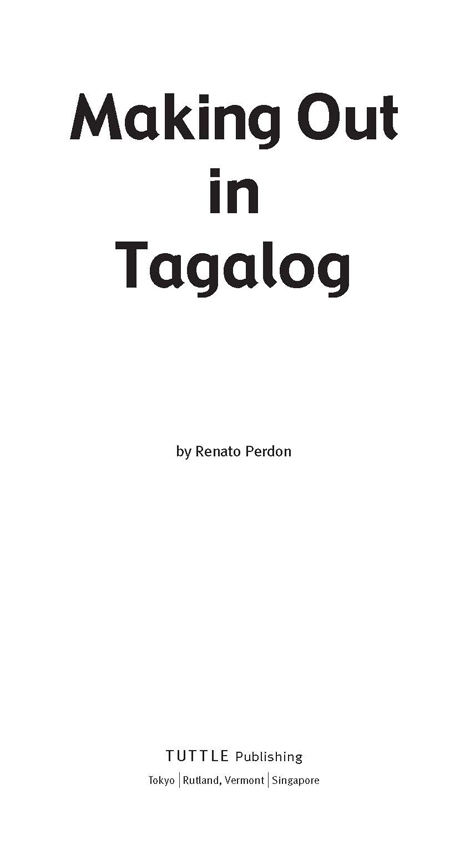
Published by Tuttle Publishing, an imprint of Periplus Editions (HK) Ltd.
www.tuttlepublishing.com
Copyright 2003 Periplus Editions (HK) Ltd.
All rights reserved. No part of this publication may be reproduced or utilized in any form or by any means, electronic or mechanical, including photocopying, recording, or by any information storage and retrieval system, without prior written permission from the publisher.
ISBN 978-1-4629-0269-9 (ebook)
Previously published in 2003 as Making Out in Filipino
ISBN 978-0-8048-3373-8
LCC Card No.: 2003111317
Printed in Singapore
Distributed by:
North America, Latin America & Europe
Tuttle Publishing
364 Innovation Drive
North Clarendon, VT 05759-9436, U.S.A.
Tel: 1 (802) 773 8930
Fax: 1 (802) 773 6993
info@tuttlepublishing.com
www.tuttlepublishing.com
Japan
Tuttle Publishing-Yaekari Building 3F
5-4-12 Osaki, Shinagawa-ku
Tokyo 141-0032, Japan
Tel: (81) 3 5437 0171
Fax: (81) 3 5437 0755
sales@tuttle.co.jp
www.tuttle.co.jp
Asia-Pacific
Berkeley Books Pte Ltd
61 Tai Seng Avenue #02-12
Singapore 534167
Tel: (65) 6280 1330
Fax: (65) 6280 6290
inquiries@periplus.com.sg
www.periplus.com
15 14 13 12 11 12 11 10 9 8 7
TUTTLE PUBLISHING is a registered trademark of Tuttle Publishing, a division of Periplus Editions (HK) Ltd.
Contents
Introduction
Making Out in Tagalog is your passport to the living, breathing, colorful language spoken on the streets of the Philippines. It is the first book to give you access to the casual, unbuttoned Tagalog that will allow you to express yourself in restaurants, bars, and nightclubs, in crowded marketplaces, and at train and bus stat-ions. Here you will find the warm-hearted language that you can use with good friends, and also the rough-and-tumble language you can fall back on when you are ready for a fight.
This brand of Tagalog is simple and direct. It is spoken mainly in Metro Manila, large cities and provincial capitals, but can be understood anywhere in the Philippines. It has shed the complex grammatical twists and turns of the highly formal language that textbooks and language courses strive so hard to teach.
Making Out in Tagalog will be a useful companion throughout the Philippineseven when traveling in remote barrios or outbacks. So you want to meet people, make friends, eat out, go dancing, or just engage in friendly chitchat? A quick glance at Making Out in Tagalog and youll have the language at your fingertips.
Information
If you have spent many years grappling with the complicated grammatical structures of French, German, Italian or Spanish, you will find Tagalog, especially the informal version in this book, a joy.
The easy-going language spoken today on the streets of the Philippines evolved from Tagalog, one of the many local languages in the country that developed over the centuries as traders from hundred of ethnic groups mixed and mingled from all parts of the world. From as early as the 12th century, Chinese and Arab traders flooded the language with their own vocabularies, as did the neighboring islands of Indonesia and mainland Asia, and later the Spanish and the Americans. For the next 300 years after the Spanish colonization of the islands in 1571, the Philippines became a melting pot where the east met the west. The Philippines, particularly in its economy, society and culture, was forever changed. The west and its people brought with them distinctly new ways of living, believing, creating and relating to others that eventually enriched the spoken language. Intramuros, the Walled City of Manila, became an international port of call competing with Batavia, now Jakarta. Foreign consular offices of the Netherlands, Great Britain, Germany, France, Russia and the USA in Manila were active in the promotion of their respective commercial interests.
The almost 50 years of American occupation from 1898 onwards added to the western outlook of the Filipinos in dealing with one another, and particularly with the outside world. Todays Tagalog slang has kept much of the directness of the old street lingo:
Kumain ka na ba? | Have you eaten? |
(You already eat?) |
Hindi pa. | l havent eaten yet. |
(Not yet eat.) |
Gusto mo bang kumain? | Do you want to eat? |
(Want eat?) |
Oo, tayo na! | Yes, lets go! |
(Yes, cmon go!) |
Kakain ba tayo sa restoran? | Shall we eat at the restaurant? |
(We go to restaurant?) |
Hindi doon, pumunta tayo roon kahapon! | Not there, we went there yesterday! |
(No, go yesterday!) |
Pronunciation
Filipino is the national language of the Philippines and is based on Tagalog, one of the major languages of the country. Dont be fazed when you make an error in your communication with native speakersyou will learn a lot from the interactions anyway. Practice in proper pronunciation is a big help.
The Filipino alphabet, adopted in 1987, consists of 28 letters. It is the same as the English alphabet except for two additional letters: , ng .
As you learn the appropriate pronunciation, speaking in Tagalog will not be difficult. Anyone with a basic knowledge of English and Spanish pronunciation will easily become familiar with the standard pronunciation of Tagalog words.
The imitated pronunciation should be read as if it were English (except which came from the Spanish language), and bearing in mind the following main points:
Consonants
b as in bat | b aboy (pig) |
c as in census (also spelled s ) | c inag/ s inag (ray) |
d as in day | d inig (heard) |
f as in food | F ilipino (Filipino) |
g as in give | g amot (medicine) |
h as in hit | h igop (gulp) |
j as in jeep | dy ambori (jamboree) |
(this occurs only in borrowed words, and is often changed to dy or to h when followed by e or o )
k as in king | k amera (camera) |
l as in level | l ason (poison) |
m as in mature | m ata (eyes) |
n as in nut | asi n (salt) |
as in onion or Spanish | Seor/Se ny or (Mister) |
maana tomorrow |
ng as in sing | ng ipin (teeth) |
(but may come at the beginning or words)
p as in patriot | p era (money) |
q as in question | k walipikasyon (qualification) |
(this occurs only in borrowed words, and is usually changed to k )
r as in rat | r adyo (radio) |
s as in start | s ilya (chair) |
t as in time | t asa (cup) |
v as in veto | b arnis (varnish) |
(this occurs only in borrowed words, and is often changed to b )
Next page













